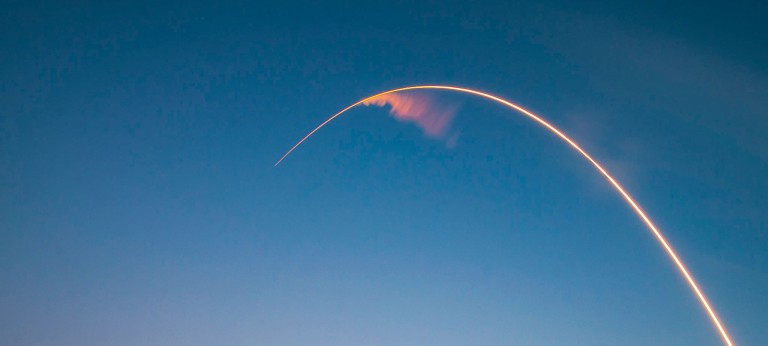AI think, therefore AI am
![{[downloads[language].preview]}](https://www.rolandberger.com/publications/publication_image/think_act_magazines_artificial_intelligence_roland_berger_cover_download_preview.jpg)
What exactly do people mean when they talk about AI in 2018? Where do I start if I want to embrace AI in my business? Get your questions answered in our Think:Act magazine on artificial intelligence.


by Fred Schulenburg
Space race 2.0 is underway. This time around it's not governments footing the bill, however – it's companies. Will the commercialization of space turn us all into space tourists? Perhaps. But it might also benefit terra firma.
Twenty minutes into the presentation the focus turns to the specifics of the passenger experience. "You could conceivably have five or six people per cabin, but mostly we would expect to see two to three," explains Elon Musk as he guides his audience through the detailed projected image, moving on to reference other features such as the essential storage facilities, the galley and the "entertainment area". The delivery is so matter of fact that it almost sounds like a routine sales pitch for an upscale tourist offering. What Musk was describing at a conference in late September in Australia was, in fact, nothing short of extraordinary. The billionaire founder and head of SpaceX was spelling out his plans to send BFRs (Big Fucking Rockets) to Mars. Within the next decade Musk says that he hopes to send a fleet of rockets to the red planet, loaded with equipment and materials to establish a base camp, to be followed later by humans.
It would be easy to dismiss this as fantasy. But Musk, who made his fortune through a series of smart investments in groundbreaking technology ventures such as PayPal and his battery-powered Tesla cars, has form. The 46-year-old South African-born Canadian American has already demonstrated his credentials in space through the successful launch of rockets by SpaceX, which has established itself as a low-cost provider in the sector.
Musk is also not the only rich person to be directing terrestrial wealth toward the stars. The ranks of billionaires with bold ambitions for space exploration also include Jeff Bezos, CEO of Amazon, Richard Branson, founder of Virgin Group and Microsoft co-founder Paul Allen. The wealthy are just one of the driving forces behind a "new Space Age" that is not only capturing the imagination of the public with its eye-catching plans, such as Musk's mooted mission to Mars, but is now also grabbing the attention and money of some hardnosed investors.
This is a marked change for a sector that, after the flush of big state investment and public enthusiasm that accompanied its early decades during the Cold War, lost its sparkle as attention waned and funds were cut. Now with plans for the first fee-paying commercial travelers to go to space in 2018, the mind-boggling ambitions of the likes of Musk, visions of manufacturing and mining facilities beyond the earth's atmosphere and a new generation of mini satellites that can sit in the palm of your hand, space is back. "Here's to the crazy ones," is how Ted Cruz, the hawkish US senator from Texas, opened a recent congressional committee on public-private partnerships in space, borrowing a phrase from Apple founder Steve Jobs as he celebrated the renaissance of the Space Age.
To some experts it never went away, it just changed. Carissa Christensen, CEO of Bryce Space and Technology, has been analyzing the development of the space sector for over two decades. During that time she has seen how the evolution of areas such as satellite communications brought with it an "institutionalized commercial space economy" in which private sector companies worked alongside state entities. "People don't realize how relevant the space economy is," says Christensen. "There is hardly an aspect of life now that is not touched by satellites."
"There is hardly an aspect of life now that is not touched by satellites."
More recently, however, she says there has been a change with the arrival of two new types of investors. The first are the billionaires, who are passionate about space and are now changing the market with new business practices. The second is venture capital, which once avoided space ventures on the grounds of the sheer cost. That has now changed, thanks in part to innovations such as reusable rocket parts, which reduce the cost of launches, or the development of smaller "mini" satellites – some as small as 10 cm cubed and one kilo in weight – which are playing an increasingly important role in the data economy. "These two factors have combined to make for an interesting development," says Christensen.
A lengthy report put out by investment bankers Goldman Sachs entitled "Space: The Next Investment Frontier" documents the changes taking place in launch and satellite manufacturing that are driving down costs and, as a consequence, lowering the barriers to participation. Renewed government interest in supporting space combined with the privatization of exploration is spurring investment. In the private sector alone some $13 billion has gone into startups since 2000, with the bulk falling in the last decade.
The result is a dizzying world in which "space tourism" and asteroid mining will become viable. The upbeat assessment pulls few punches, stating that the "space economy is also now inflecting and we believe will become a multi-trillion dollar market within the next two decades." Among the possible changes in the space economy pointed to are Sir Richard Branson's ambitions to offer paying passengers a seat on a suborbital spacecraft for $250,000 – a bargain when compared to the $35 million cost of a "tourist seat" on a Soyuz rocket. Or the $25-50 billion valuation put on the platinum that might one day be mined from an asteroid.
The new space age is set to be more global than its earlier editions when the sector was largely dominated by the US, Russia and the EU. Now participants are as likely to come from India and China. One of these newcomers is Rahul Narayan, founder of TeamIndus. His Bangalore-based group is working on a project to land a spacecraft on the moon as part of the Google Lunar XPRIZE competition. This is a global challenge to any privately funded team to develop low-cost methods of space exploration. The goal is to successfully land a craft on the moon's surface, then have it travel 500 meters and transmit high-definition video and images back to Earth. First prize is $20 million.
Narayan, whose background was in software, says that TeamIndus was born out of the desire to see what was possible and to see if it could be done from India. "It was a dream," he says, a dream that has now made it into the competition's final five. Funding initially came from the founders and their families. Since then other investors have come in and the company is looking to sell payload space. All in, the venture will cost between $65-$70 million, of which they have raised about half.
"We initially saw the moon mission as the end point. Now it is the starting point."
The team's ambitions have changed over the course of the project. "We initially saw the moon mission as the end point. Now it is the starting point," says Narayan. The lunar project may have no direct commercial benefit, but the impact this will have on India as a country will be considerable. The abilities built up by TeamIndus will be capable of being used across the space economy, including in remunerative areas such as the deploying of satellites. But for him the real benefit of the competition is that it is "a testimony" to incentivized enterprise: "Space was the only industry that had not been disrupted by startups." He sees a new trend in which smaller operators will be able to bite into the share of bigger players, and where non-US companies can flourish.
With the private sector taking up more of the initiative, the role of state enterprises such as NASA is changing. "NASA's role today is totally different from what it used to be," Charles Bolden, a former astronaut who stood down as head of NASA earlier this year, told the "Financial Times". "We used to be competing, for example, with Roscosmos [the Russian space agency]. Today we are the integrator. NASA is the agency that brings the other space agencies of the world together, particularly for human spaceflight."
There are of course a lot of outstanding questions. The cost of space tourism may be set to fall but is unlikely to be within the reach of anyone but the very wealthy. There is also some unease that an endeavor that used to be about expanding human knowledge and understanding may become little more than an entertainment experience – "rich person's bungee jumping" as some critics have dubbed it. And as for astral mines and factories, that may also be a while away. "At some point large numbers of humans will live and work in space," says Carissa Christensen. "But I do not think that point is in a time frame that is relevant to today's business cycle." She is skeptical about an "asteroid gold rush."
Yet while the more ambitious goals may take a long time to reach, a number of the benefits that space has delivered to the real, earthbound economy came almost as by-products. Rahul Narayan argues that this will continue to be the case. "Its benefits will be unpredictable," he says. And in his presentation in Australia, Elon Musk also offered up an unexpected consequence of his mega bet on the huge rockets. As well as one day heading out to Mars, it could actually be deployed on Earth to take passengers anywhere on the planet in around 30 minutes. The mind-boggling technological achievements may end up being enjoyed closer to home as passengers in the future settle into one of those cabins ahead of a 39-minute flight from New York to Beijing.

![{[downloads[language].preview]}](https://www.rolandberger.com/publications/publication_image/think_act_magazines_artificial_intelligence_roland_berger_cover_download_preview.jpg)
What exactly do people mean when they talk about AI in 2018? Where do I start if I want to embrace AI in my business? Get your questions answered in our Think:Act magazine on artificial intelligence.
Curious about the contents of our newest Think:Act magazine? Receive your very own copy by signing up now! Subscribe here to receive our Think:Act magazine and the latest news from Roland Berger.